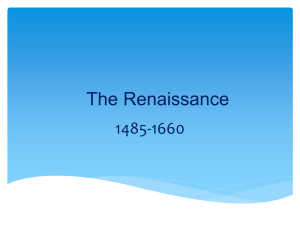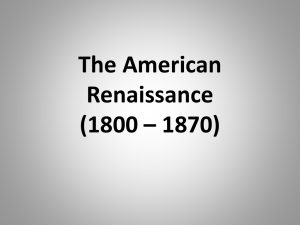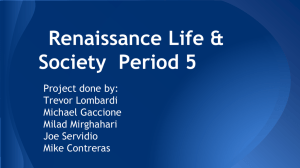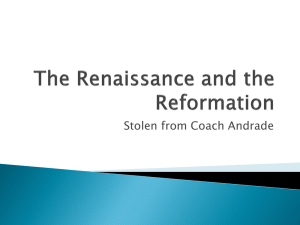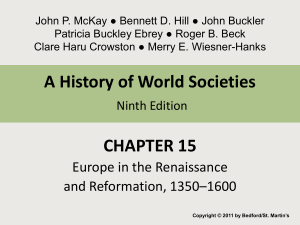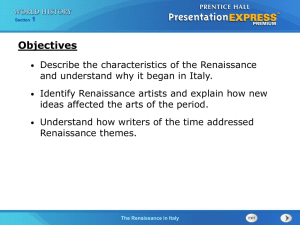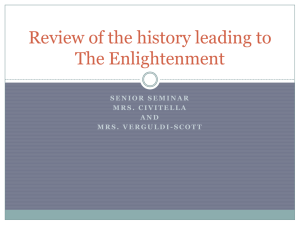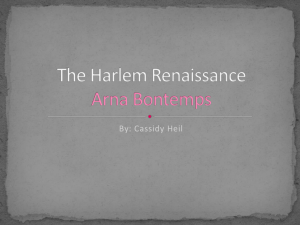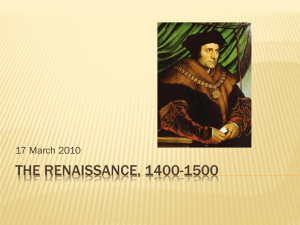European Renaissance and Reformation
advertisement
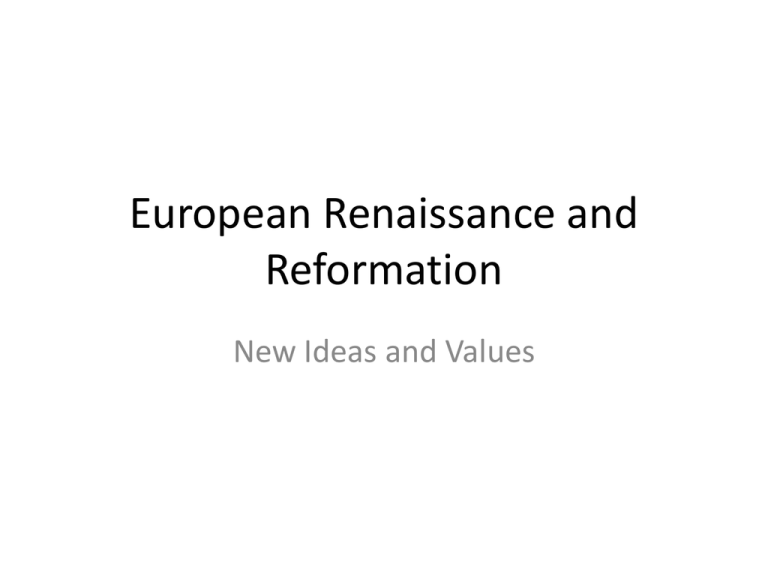
European Renaissance and Reformation New Ideas and Values Italy: Birthplace of the Renaissance • During the Middle Ages, Europe suffered from both war and plague. Those who survived wanted to celebrate life and the human spirit. • They began to question institutions which had been unable to prevent war or to relieve suffering brought by the plague. • Some people questioned the Church, which taught Christians to endure suffering while they awaited their rewards in heaven. Italy’s Advantages • In Italy, writers and artists began to express this new spirit and to experiment with different styles, greatly changing how Europeans saw themselves and their world. • This movement that started in Italy caused an explosion of creativity in art, writing, and thought that lasted approximately from 1300 to 1600. Historians call this period the Renaissance (REHN-ih-SAHNS). Italy’s Advantages • The years 1300 to 1600 saw a rebirth of learning and culture in Europe called the Renaissance. This rebirth spread north from Italy. It began there for three reasons. • First, Italy had several important cities. Cities were places where people exchanged ideas. • Second, these cities included a class of merchants and bankers who were becoming wealthy and powerful. This class strongly believed in the idea of individual achievement. Italy’s Advantages • Third, Italian artists and scholars were inspired by the ruined buildings and other reminders of classical Rome. • 1. What are three reasons why the Renaissance began in Italy? • It had several important cities; these cities included a class of merchants and bankers; and artists were inspired by the classical ruins there. Classical and Worldly Values • The new interest in the classical past led to an important value in Renaissance culture – humanism. This was a deep interest in what people have already achieved as well as what they could achieve in the future. Scholars did not try to connect classical writings to Christian teaching. Instead, they tried to understand them on their own terms. Classical and Worldly Values • In the Middle Ages, the emphasis had been mostly on spiritual values. Renaissance thinkers stressed secular ideas. These ideas centered on the things of the world. • One way that powerful or wealthy people showed this interest in worldly things was by paying artists, writers, and musicians to create beautiful works of art. Wealthy people who supported artists were known as patrons. Classical and Worldly Values • People tried to show that they could master many fields of study or work. Someone who succeeded in many fields was admired greatly. The artist Leonardo da Vinci was an example of this ideal. • He was a painter, a scientist, and an inventor. Men were expected to be charming, witty, welleducated, well mannered, athletic, and selfcontrolled. Women were expected to have many accomplishments, too. But women were not to show them in public. Classical and Worldly Values • What are secular ideas? • Secular ideas are ideas centered on the things of the world. The Renaissance Revolutionizes Art • Renaissance artists sometimes used new methods. Sculptors made figures more realistic than those from the Middle Ages. Painters used perspective to create the illusion that their paintings were three-dimensional. • Art in the Middle Ages was mostly religious. Renaissance artists reproduced other views of life. Michelangelo showed great skill as an architect, a sculptor, and a painter. Renaissance Revolutionizes Art • How did the methods and subjects in art change? • Painting became more realistic as a result of the use of perspective; its subject changed to go beyond only the religious. Renaissance Writers Change Literature • Renaissance writers also achieved greatness. Several wrote in the vernacular. This means they wrote in their native languages. It was a change from the Middle Ages, when most writing was done in Latin. • Writers also changed their subject matter. They began to express their own thought and feelings. Sometimes they gave a detailed look at an individual. Renaissance Writers • Dante and others wrote poetry, letters, and stories that were more realistic. • Niccoló Machiavelli took a new approach to understanding government. He focused on telling rulers how to expand their power. He believed rulers should do what was politically effective, even it if was not morally right. • Renaissance writers wrote about their own thoughts and feelings; they also took a more detailed look at the individual. Contributions of the Renaissance • Accomplishments in the visual arts: Michelangelo, Leonardo da Vinci. • Accomplishments in literature (sonnets, plays, essays): Shakespeare • Accomplishments in intellectual ideas (humanism): Erasmus Essential Understanding • New intellectual and artistic ideas that developed during the Renaissance marked the beginning of the modern world. The Northern Renaissance • By 1450, the bubonic plague had ended in northern Europe. Also, the Hundred Years’ War between France and England was ending. This allowed new ideas from Italy to spread to northern Europe. They were quickly adopted. • Rulers and merchants used their money to sponsor artists. But the northern Renaissance had a difference. Educated people combined classical learning with interest in religious ideas. Northern Renaissance • How was the northern Renaissance different from the Renaissance in Italy? • In northern Europe, Renaissance thinkers combined classical learning with religious thinking. Artistic Ideas Spread • The new ideas of Italian art moved to the north, where artists began to use them. Major artists appeared in parts of Germany, France, Belgium, and the Netherlands. • Dürer painted religious subjects and realistic landscapes. Holbein, Van Eyck, and Bruegel painted lifelike portraits and scenes of peasant life. They revealed much about the time. Artistic Ideas Spread • They began to use oil-based paints. Oils became very popular, and their use spread to Italy. • What did northern European artists paint? • They showed their own lives and times in realistic ways. They often painted lifelike portraits and scenes of peasant life. Northern Writers Try to Reform Society; The Elizabethan Age • Writers of the northern Renaissance combined humanism with a deep Christian faith. • They urged reforms in the Church. They tried to make people more devoted to God. They also wanted society to be more fair. • In England, Thomas More wrote a book about Utopia, an imaginary ideal society where greed, war, and conflict do not exist. What did northern writers write? • William Shakespeare is often called the greatest playwright of all time. • His plays showed a brilliant command of the English language. • They also show a deep understanding of people and how they interact with one another. Northern Renaissance Writers • Who were two of the most famous writers of the northern Renaissance? • The most famous writer was William Shakespeare. Also famous was Thomas More. Printing Spreads Renaissance Ideas; The Legacy of the Renaissance • One reason that learning spread so rapidly during the Renaissance was the invention of movable type. • The Chinese had invented the process of carving characters onto wooden blocks. They then arranged them in words, inked the blocks, and pressed them against paper to print pages. Printing Spreads Renaissance Ideas • In 1440, a German, Johann Gutenberg, used this same practice to invent his printing press. • He produced his first book – the Gutenberg Bible – in 1455 on this press. • The technology then spread rapidly. By 1500, presses in Europe had printed nearly 10 million books. Printing Spreads Renaissance Ideas • Printing made it easier to make many copies of a book. As a result, written works became available far and wide. • Books were printed in English, French, Spanish, Italian, or German. More people began to read. The Bible was a popular book. • After reading the Bible, some people formed new ideas about Christianity. These ideas were different from the official teachings of the Church. Printing Spreads Renaissance Ideas • The Renaissance prompted changes in both art and society. Artists and writers portrayed people in more realistic ways and celebrated individual achievement. • In a larger sense, the Renaissance opened up a world of new ideas to people and led them to examine and question things more closely. The Legacy of the Renaissance • What effects did the printing press have on northern European life? • People read more. They also began to read the Bible on their own, which led to their forming their own ideas about Christianity.
